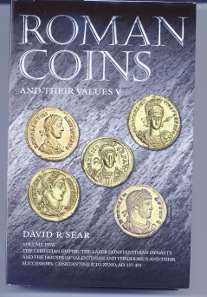by Björn Schöpe
May 14, 2015 – Let’s face it: what collector does really need the RIC? If we exclude those collectors who also work as scholars on their field of special interest, remains only one point in favour of the RIC: the gigantic mass of information. But that is not necessarily a cause for concern for all those who cannot afford a complete RIC. Because now there is a remedy: the ‘Millenium Edition’ of Sear’s standard work on Roman coins.
David R. Sear, Roman Coins and Their Values. ‘Millenium Edition’. Volume V: The Christian Empire: The Later Constantinian Dynasty and the Houses of Valentinian and Theodosius and their Successors, Constantine II to Zeno, AD 337-491. Spink, London, 2014. 575 p., black-and-white images throughout. 22.2 x 15 cm. Hardcover. ISBN: 978-1-907427-45-9. 50 GBP.
In 1964 appeared the first edition of David R. Sear’s one-volume reference book to Roman coins. It was compact and offered a thorough overview of the issues of the Roman Republic and Empire until the end of the fifth century AD. Sear indicated only one price of the coins referring to different conditions according to the metal of the coins. The fourth and last edition of this book of 1988 is still widely popular and currently lies beside me on my desk, too.
At this time the gap to comprehensive corpora like the Roman Imperial Coinage or the older Cohen was, naturally, large and a flaw in the eyes of many ambitious collectors. For that reason by the end of the 1990s David Sear started a new edition, his ‘Millenium Edition’. Originally it was planned to comprise two volumes, but actually it has become a five-volume work whose last volume has just appeared with Spink. This is all the more admirable as many such a large-scale projects (particularly in the scholarly world) are cut in the middle of the way.
Structure and layout of this new edition is analogous to the classical one-volume edition. This seems quite reasonable as the shape has stood the test. The introduction offers collectors information on motifs and dating, mints and denominations, and an alphabetical index allows to quickly find all emperors even those whose exact dates of rule have just slipped one’s memory (a common weakness, particularly when dealing with the quite confusing third century or the Late Antiquity).
Two conspicuous variations from the old Sear are commendable, though. There are no more plates at the end of the book but all images have been included right in the text where the relative coin is dealt with. So, no more turning pages and looking for the correct numbers when checking out a photograph. And then all coins are equally given prices in two conditions: VF (very fine) and EF (extremely fine).
The new, fifth volume alone spanning the time from Constantine’s sons to Zeno and Romulus Augustulus comprises nearly 500 pages of catalogue and almost 4,700 coins! For comparison: the one-volume Sear in the fourth edition offers around 4,300 coins on a bit more than 400 pages for the complete Roman Republic and Empire.
David Sear emphasizes that his work is intended to help readers find a ‘natural way’ to think about history through coins. Deliberately he has not written an academic reference work because to that purpose there are still corpora like RIC.
Collectors, however, can unreservedly rejoice. At a very affordable price (250 pounds, currently around US$ 385, for all five volumes) one can put a five-volume reference work to Rome’s coins in one’s own book shelf that has not only the benefit of being much more up-to-date than most academic reference works. The mass of information is also highly impressive and deals with the needs and questions of collectors especially by offering current prices.
The only downer is that you cannot take the complete Millenium Edition to a coin show. But, after all, you can’t do that with the RIC neither, and everyone has got the one-volume Sear, anyway.
The five volumes are available at Spink’s.





